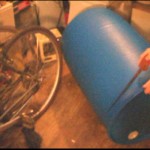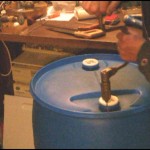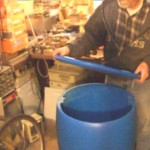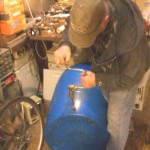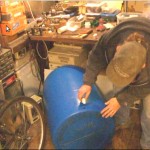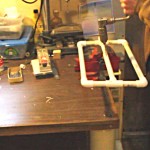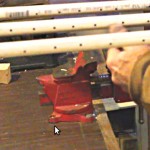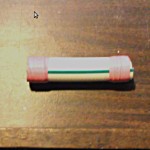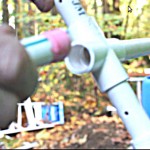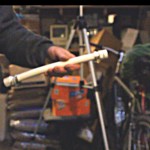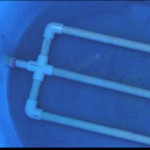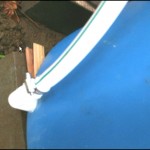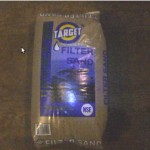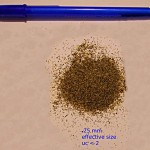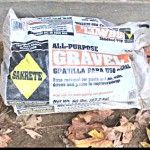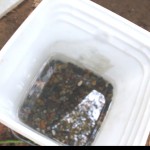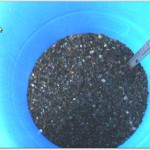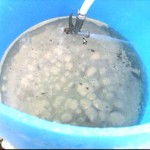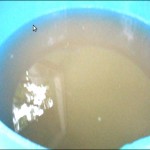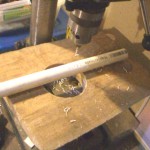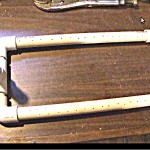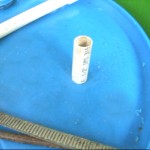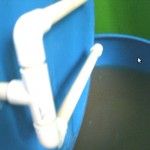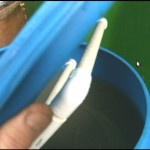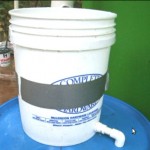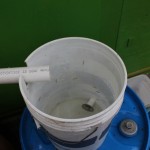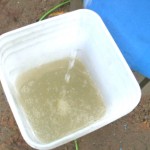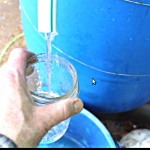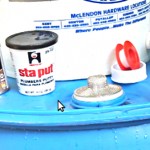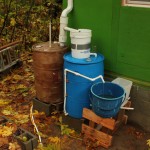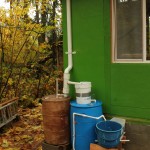Are there THMs or HAAs in the water you drink? Unless you are on a well, or use a slow sand filter, or do not get your water from a source that has been treated with Chlorine, you are probably drinking these every day. Most public water is “disinfected”. This means the bad microbes are killed – but not removed. ( Note that a biological sand filter (slow sand filter) actually removes bad microbes – a process known as purification.) Most public water supplies do not supply purified water. The chlorine and/or ozone that must be used reacts with the dead microbes which in turn produces the THMs and/or HAAs. These chemicals are cancer causing if consumed over long periods of time. The alternative, however is much worse. If drinking water is not disinfected lots of people will get really, really sick. Are there any other alternatives?
Now, if slow sand filtration was used in conjunction with some form of disinfection such as UV sterilization; the THMs and HAAs would be reduced considerably, if not completely eliminated because slow sand filtration removes disease causing microbes and organic matter from water. The UV sterilization is not needed all the time but is used as a precaution.
Read about THMs and HAAs here:
http://www.env.gov.nl.ca/env/waterres/quality/drinkingwater/haa.html
and here:
http://www.ewg.org/reports/dctapwater
Slow sand filters use “natural” water filtration,
http://www.shared-source-initiative.com/biosand_filter/biosand.html
very similar to the action of water filtration that occurs in a wetland:
http://techalive.mtu.edu/meec/module12/Chemicalfunctionsofwetlands.htm
( how do people think water is recycled “naturally”? does anyone bother to check? A search on the phrase “how does a wetland filter water” (without the quotes) brings up over 2 million hits).
From the top of the political machine, there are a whole basket full of excuses justifying the lack of attention to slow sand water filtration – most centered around cost, and “so called” antiquity and impracticably; however. . . . . . . . One city in the state of Oregon, has got it right:
http://www.cityofsalem.net/Departments/PublicWorks/Operations/Water%20Services/Pages/SlowSandFiltration.aspx
I have been there. We stopped there on the way to Las Vegas to fill our water containers. The best water I have ever had, outside of our own well water.
People are getting cheated (albeit not necessarily on purpose) daily by profit-centered water distribution system owners. Sure, the water is “safe” from a biological standpoint – usually. Without clean water, we get horribly sick, without water we cannot live, on a hot summer day, a person will be too weak to move after 3 days without water . . . . water is really,
really
important. Now if you are on a well, you already know all this, but what if the well runs dry, or gets polluted? Where we are here, about 8 years ago, developers drilled a huge well and ran a 12 inch line to several thousand new houses about 2 miles from here. As this massive pump has drawn water from the aquifer, the level in our well has gone down considerably, soon we will be out of water (when we replaced the well pump, the rust rings from where the water level used to be were obvious). The well driller told me it takes 7 years for the rainwater to seep through the sandstone to recharge the aquifer. I would imagine there are others in the same situation elsewhere in the world.
To compound the water pollution situation; “fracking” that oil companies are using to force petrol out of rocks has made some water wells useless by contaminating subsurface water. This is even worse than depletion, because that water, for human purposes, will NEVER be usable again. Think about that – carefully.
http://www.vanityfair.com/business/features/2010/06/fracking-in-pennsylvania-201006
http://www.foodandwaterwatch.org/water/fracking/
http://www.gaslandthemovie.com/whats-fracking
Donald L Marcus, Chris Bonds, Results of the reactant sand-fracking pilot test and implications for the in situ remediation of chlorinated VOCs and metals in deep and fractured bedrock aquifers, Journal of Hazardous Materials, Volume 68, Issues 1-2, 12 August 1999, Pages 125-153, ISSN 0304-3894, 10.1016/S0304-3894(99)00035-7.
And even this super right-wing source has concerns:
http://online.wsj.com/article/SB10001424052970203804204577013771109580352.html
Those involved in the profit producing aspect of fracking have only good things to say about it . . . I wonder where they get their water from and if they actually believe their sales pitch about their “wonderful new Green technology”?
http://www.hydraulicfracturing.com/Pages/information.aspx
http://www.energyfromshale.org/what-is-fracking?gclid=CIvRuJDRmqwCFUcaQgodZ0CkOg
Now, admittedly, our wonderful technology is highly likely to be able to purify the water that fracking has contaminated – distillation would probably work – but who pays for that and when does it happen? It certainly will not be the oil companies that pay for it, and it won’t happen until there is a dire need for water.


